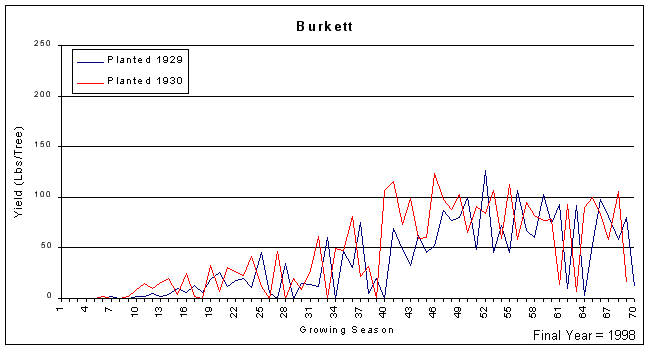Burkett

| # Nuts/lb. | % Kernel | Kernel quality breakdown | Specific gravity | ||
| % Fancy | % Standard | % Amber | |||
| 54 | 53 % | 9 % | 34 % | 11 % | .73 |
History
The original tree of this cultivar was discovered in the fall of 1900 by Omar and Joe Burkett, sons of J.H. Burkett, who was a pioneer in pecan culture. The tree was situated on the bank of Battle Fish Creek, Callahan County, TX. In 1903 J.H. Burkett transferred two buds of the original tree to a seedling. The original tree was destroyed by a competition for the propagation rights. Mr. Burkett began to disseminate 'Burkett' scions in 1911. At one time, 'Burkett' was the most popular and profitable cultivar in Texas. 'Burkett' has been used in breeding and two cultivars, 'Apache' and 'Comanche' with 'Burkett' parentage, have been released. (Sparks, 1992).
Comments
*Note: This is an older cultivar planted in the Old Variety Test at the Tifton Campus. Trees were planted decades ago when care was very different than it is now, and trees received much less care, so production data will reflect this fact. Trees began receiving insecticides in 1962, fungicides in 1970, nitrogen in 1962, and drip irrigation in 1975. The data for this cultivar was collected by several individuals, but the bulk of the data and the comments are from my predecessor Dr. Ray Worley. This information was originally published here: Worley and Mullinix, 1997.
Round-shaped nut similar to a large hickory nut, consistent bearer. Flecking on seed coat reduces kernel grade. High percent kernel. Nuts frequently split at suture. Spreading tree. Not recommended.
Production record of test trees beginning in year planted
'Burkett' production from the Old Variety Test. Each colored line represents the yearly production in pounds of nuts from an individual tree beginning the year planted.
Alternate Bearing Intensity*= 0.29
*Computed from mature trees using data from years after trees began receiving fertilizer and pesticide sprays.

